Erstellt am: 30. 10. 2013 - 15:27 Uhr
The City of Wine
At Milestii Mici in Moldova, I`m riding in a shiny four-wheel drive vehicle as it enters through a cave door in the belly of a limestone mountain and plunges into a half-lit, gently curving tunnel. Over the shoulder of the taciturn, thickset driver, who is wearing a sharp suit, I can see the headlights pick out endless rows of giant barrels. At a junction there`s a subterranean water fall. It`s all wonderfully surreal. I`ve never felt more like James Bond.
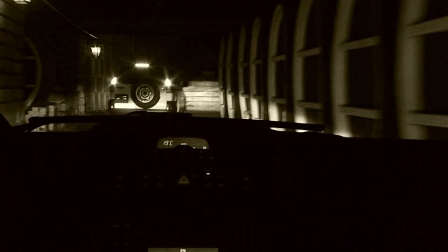
chris cummins
"These tunnels stretch for 200km,” announces guide Lilli Ciotka, smiling as she leans around from the front passenger seat, “so I hope we don`t run out of gas.” There are strange patterns on the walls – relics of the cutting machines that chiselled out the rock when, for 200 years, these tunnels were mining galleries used to extract the limestone that was once used to build Chisinau, the nearby Moldovan capital, just an hour down the road. Chisinau is still fondly called “The White City” although the Soviet architects, with their boundless enthusiasm for concrete, did their very nest to make it look grey.
Into the Bowels of the Mountain
According to the young journalists I´d met the night before in a rustic bar in the nearby capital Chisinau, the Soviets have a lot to answer for in Moldova. They`d left behind generations of inhibited people scared to voice opinions, tackle power or show initiative. “We have so much corruption,” one young journalist, Diana Railean, had complained, “but we don`t dare tackle it.”
But it has to be conceded that the Soviets had at least one bright idea during their time in charge in Moldova: in 1960 they turned the former mine at Milestii Mici into the world`s biggest wine cave.
“We have the best conditions here,” says Lilli Ciotka with pride as the vehicle rumbles ever further into the innards of the mountain, “with the optimal temperature of between 12 and 15 degrees and a humidity of over 80%.”

chris cummins
Lilli calls the labyrinth, which is protected by UNESCO, a “city of wine”. Indeed, the side tunnels that branch off from the main thoroughfare are called “streets”, each named after the various grapes such as “Pinot” and “Cabernet Sauvignon” used to make the wines. The streets are lined with massive oak barrels, each one holding an average of six or seven thousands litres. The wood has been brought from Ukraine, Russia and sometimes France and worked into barrels here inside the dimly lit caves.
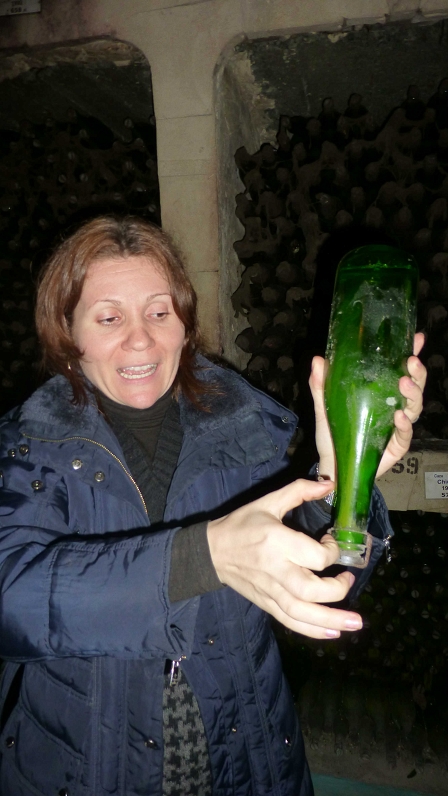
chris cummins
Lilli claims they are cleaned inside by “small women” who are dainty enough to squeeze inside the small openings in the side of the barrels. I can never tell when she is pulling my leg. She confidently explains that the Moldovan flag is “blue for the sky, yellow for the bread and red for the wine,” before shrugging her shoulders and admitting with a smile: “well, that could be one interpretation.”
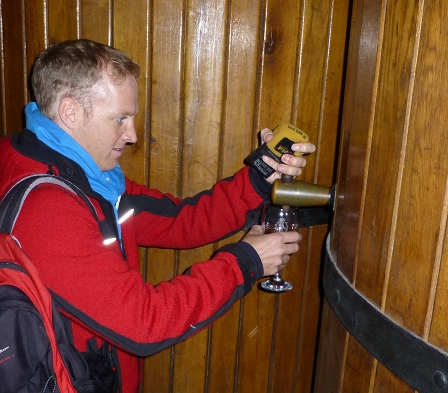
chris cummins
Then she tells me to pour some wine out of a tap of giant barrel. As I bend down obediently Lilli gently slides the barrel to one side. The barrel reveals itself as the secret door of an opulent tasting room.
Once again the sense of the surreal is overpowering. There is a chandelier, a statue of Bacchus and a group of fiddlers welcoming guests.
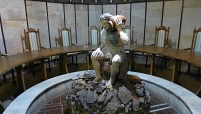
chris cummins
I half hope to see a man stroking a white cat. But instead I taste a dizzying array of white and then red wines with temptress Lilli, whose enthusiasm knows no bounds as we sip a particularly dark specimen. “This is a very deep very deep red wine, a very bodied wine that tastes like chocolate, caramel, smoky dry plums, raspberries and lots of spices, “she announces, her voice rising to a crescendo, before pausing and adding, in a thoughtful aside, that the wine “is particularly recommended by doctors.”
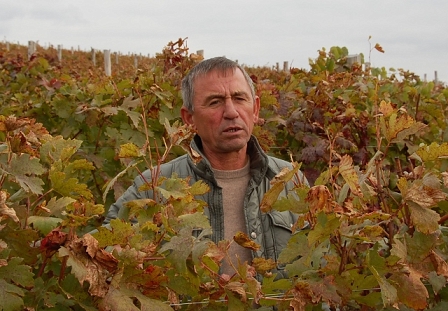
ADA
Before I can boost my health any further, the fiddlers strike up again and the Vice Minister of Agriculture, Ion Sula, arrives to discuss his plans for a resurgence of the industry that is a vital prong in Moldova`s efforts to attract revenue and foreign investment. Sula is muscular looking and dark haired and is young for a top-ranking official. He is informal in style and has a head full of figures that he rattles off unprompted: “We currently have 145,000 hectares of vineyards producing 500,000 tons of wine grapes every year.” He adds that exports last year were worth around $200m making up 40% of Moldova`s total revenue from agriculture export.
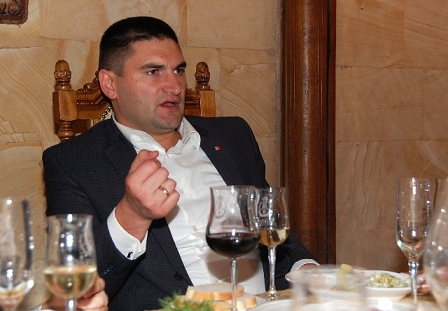
ADA
The expansive vineyards, now yellowed in autumn, dominate Moldova’s landscape of gently rolling hills. As I drove through them the previous day, they looked like waves of gold. The vineyards lie at the same latitudes as the French regions of Bordeaux and Bourgogne and typically enjoy long sunny summers. Wine making employs around 27% of the country`s labour force.
Properly managed and developed the industry could help Moldova climb its way up from the bottom spot in Europe`s Human Development Index. As things stand this is still officially the “poorest country in Europe”.
It`s the rich heritage that Sula wants to highlight. “We have been making wine since before the birth of Christ.” Indeed the Ministry of Trade claims that grapes have been cultivated in this region for at least 5,000 years.

chris cummins
Moldovan wine used to enjoy a good reputation in Western Europe. Apparently Queen Victoria of England was fond of a glass of the tannin dark Negru de Purcari and the French were particularly partial to Moldova sparkling wine. During the cold war, the Soviet mass industrialisation of the Moldovan wine culture led to a greater focus on quantity rather than quality and west of the Iron Curtain consumers largely forgot about Moldovan wine.
Dieses Element ist nicht mehr verfügbar
But, now, 22 years after independence, its international reputation is gradually improving and its export market is more diverse than ever. 55 countries import Moldovan wine and there are great enthusiasts in China. Indeed rich businessmen from the East have even hired private cubby holes within the Milestii Mici complex that look like small barred shrine. Yet over a third of Moldovan wine is shipped to European Union countries.
Russia vs. The EU
The industry is currently facing a crisis. On the 10th of September Russia, which traditionally imports over 25% of Moldova`s wine, has imposed an import ban on Moldovan wines, citing health concerns. According to the Interfax news agency, Russia's public health chief Gennady Onishchenko said that ban was “ a necessary step that we have undertaken reluctantly, but it is the only possible way of solving the present situation." Yet the wine, which is subject to the 2006 Grape and Wine Law, has passed stringent EU quality control checks and many observers, inside and outside Moldova, feel the ban is a punitive measure. “We consider this kind of blackmail totally unacceptable,” says Wicher Slagter, the head of the EU delegation to Moldova. “It is not the way that countries should deal with each other.”
Many suspect the move was provoked by Moldova`s moves towards signing a free-trade agreement with the EU at its "Eastern Partnership" summit in Vilnius in late November. The Kremlin which had wanted Moldova to join its rival free trade initiative, the Customs Union. Sula prefers not to comment on Russia`s declaration but says he hopes the ban won`t last long. The ban has been partly offset by a decision by the European Commission, on September 25, to fully open the EU market for imports of Moldovan wine.
Announcing the move, Dacian Cioloş, Commissioner for Agriculture and Rural Development said “This decision will allow investing in Moldovan wine industry according to the perspectives of the European market.” Yet if Moldovan wine is to be a success in the European market, Ion Sula concedes that the industry will have to adapt to European expectations with smaller producers concentrating on more quality.
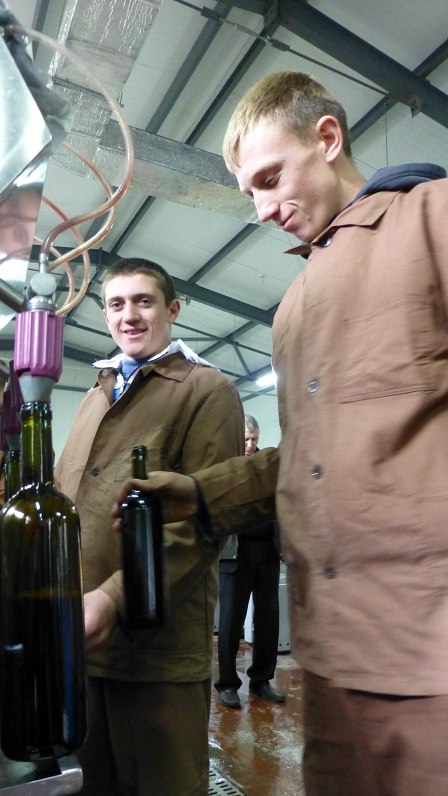
chris cummins
To help them develop in this direction, the Austrian Development Agency (ADA) has helped fund a “wine school” in the town of Nisporeni near the border with Romania. The pupils learn everything from planting and pruning the vines to the bottling and marketing of wine. ADA’s regional officer Gerhard Schaumberger accompanies around a bustling work shop. The wine is being bottled, and carefully watched over by an instructor, pupils are learning to taste.
I'll be hosting a Saturday Reality Check Special from Moldova - the poorest country in Europe. This Saturday, November 2, at 12noon.
“They are producing a great quality of wine,” says Schaumberger. “This school has already won international prizes.” ADA hopes that by helping young Moldovans find a vocation in their home country, the school will help fight against the wave of emigration that has ripped apart families and drained the rural areas of its youth. A quarter of the population has already left to search for work abroad, mostly young and dynamic Moldovans, leaving villages dominated by children and the elderly.
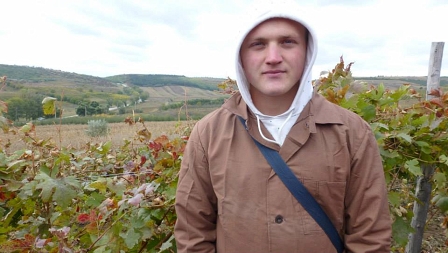
chris cummins
But as well as skills the young people will need capital. I find one student, Vadim, pruning a vineyard on a windswept hill above Nisporeni. “Of course young people should stay in the country,” he says, “but sometimes it is impossible. Sometimes you have to go abroad and make the money you can later use to invest back home.”


